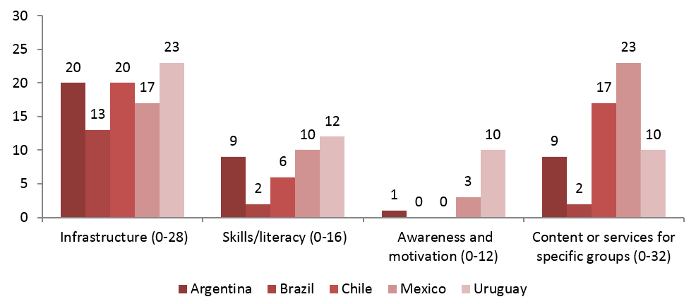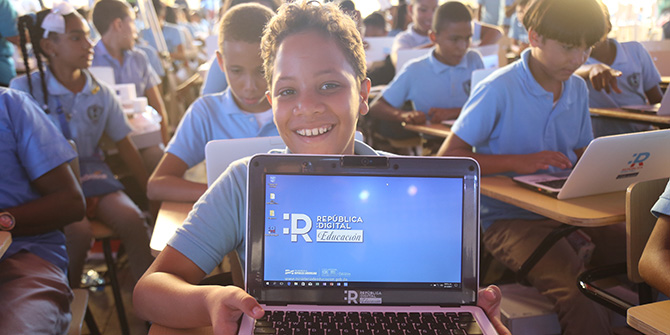 Digital inequalities policies must tailor their interventions to the problems, needs, and outcomes of specific vulnerable groups if they are to move beyond good intentions and achieve real socioeconomic change, writes Ellen Helsper (LSE Department of Media and Communications).
Digital inequalities policies must tailor their interventions to the problems, needs, and outcomes of specific vulnerable groups if they are to move beyond good intentions and achieve real socioeconomic change, writes Ellen Helsper (LSE Department of Media and Communications).
Latin America is digitising at a steady pace, with improved broadband infrastructure, a proliferation of e-services, and over half of its citizens online in 2017. Yet, it continues to fall behind Europe, North America, and Australasia on indicators such as the International Telecommunications Union’s ICT Development Index and the Organisation for Economic Cooperation and Development’s PISA measures for digital literacy.
Part of the problem is a failure to link digital agendas and digital-inclusion interventions to specific socio-economic and socio-cultural outcomes, as it is this that would allow citizens to hold governments to account for tackling digital and traditional inequalities alike.

Much as in Europe, Latin American policies assume socio-economic and socio-cultural benefits from improved access and skills training, but beyond increased use of the internet or ICTs, they fail to specify targets for specific disadvantaged groups.
The region would benefit from stronger evidence-based policymaking, as well as evaluation based on definitions and theoretical models that trace links between digital and social inequalities, yet only Uruguay’s digital agenda explicitly focuses on generating the kinds of statistics that would allow for this.
Definitions of digital inequalities make a difference to policy
In societies that are rapidly digitising, inequalities in engagement with ICTs matter because degrees of digital inclusion impact on economic, social, cultural, and personal well-being.
How this inclusion is defined is important because it influences how policies and interventions are designed, which types get priority, and which get funded, determining in turn who gets the benefits and who gets left out.
As I have recently argued, policies and interventions can only be effective in generating greater equality if they incorporate four key elements for all citizens:
- High quality access to infrastructure, devices, and software
- The ability to access, engage with, and produce content
- Availability of content tailored to the needs of all citizens
- Opportunities to translate digital engagement into beneficial outcomes
Europe is considered a global leader in this area, with infrastructure, access, and skill interventions. But my analysis of European policy shows that these focus narrowly on technical, information-navigation, and advanced skills such as coding.
Since all aspects of public and private life are being digitised, issues with communication or networking (e.g. netiquette, safe interactions), and lower level content-creation skills (e.g. creating and sharing images and documents) must also be stimulated to allow citizens to translate use of ICTs into beneficial outcomes.
The most important takeaway from this framework is that in order to reduce socio-digital inequalities, initiatives need to start from an understanding of the (non-digital) outcomes they aim to achieve and then be held accountable for their progress towards associated targets.
This means embedding digital inclusion in a number of different policy and regulation areas that deal with social challenges, as well as understanding which types of access, skills, and use (i.e. content) are most likely to help different groups to improve their situation.
The state of digital inclusion in Latin America
In Latin America, digital inclusion has been on the political agenda since 2000 when the UN Economic Commission for Latin America and Caribbean initiated a regional dialogue on the Information and Knowledge Society in order to construct coordinated Digital Agendas.
The commonly held assumption is that Latin American policies lag behind European policies, focusing only on infrastructure or access provision, as with the much-hyped, much-maligned “one laptop per child” programmes. But if we analyse these policies using the definition above, it becomes clear that this is not an entirely accurate depiction.

The table above shows the characteristics of digital inequalities policies in five Latin American countries: Uruguay and Chile were selected because they were considered regional leaders in this area; Brazil and Mexico because they are large, highly unequal countries; and Argentina because it will be the chairing the OECD and has recently implemented changes in its policy.

Figure 2 shows that most policies include targets for better access and skills as important indicators of success, but only Uruguay includes specific and broad objectives on awareness of the benefits and risks of ICT use.
However, few specify the particular problems of particular groups that will be alleviated by access to and skilled use of ICTs. Skills are discussed in a generic, technical sense as drivers of employment with little clarity on how this will occur (especially in Chile).
Some policies (Mexico, and to some extent Chile and Uruguay) identify groups and their specific challenges, and most identify problems with digital inclusion in terms of access and skills, but Uruguay’s approach for the vulnerable elderly is the only case of linkage to group-specific targets.
Brazil suggests that civil society organisations in direct contact with digitally marginalised groups should play an important role, but specifics are absent.
No policy indicates that success will be measured by an increase in socioeconomic or sociocultural wellbeing. And of course these are just policies, which cannot guarantee implementation or real, cross-sector stakeholder involvement.

The vital link between policies and socioeconomic outcomes
This disconnect between digital and socioeconomic ambitions matters, because governments need to be held accountable for outcomes: not how many people have done skills training or used the internet, but how many individuals of specific vulnerable groups have achieved certain tangible beneficial outcomes as a result of this access and engagement.
Policies and interventions that are not explicitly designed with this in mind risk amplifying existing inequalities: those who are already advantaged are most likely to exploit new access and training opportunities.
The truth is that Latin America’s digital agendas are not much better than their slightly more elaborate European counterparts: a lot of grand words and good intentions, but also a lack of accountability in terms of what really matters. Namely, decreasing socioeconomic and digital inequalities.
Notes:
• The views expressed here are of the authors and do not reflect the position of the Centre or of the LSE
• UNCS Disclaimer: The designations employed and the presentation of material on this map do not imply the expression of any opinion whatsoever on the part of the Secretariat of the United Nations concerning the legal status of any country, territory, city or area or of its authorities, or concerning the delimitation of its frontiers or boundaries. Dotted line represents approximately the Line of Control in Jammu and Kashmir agreed upon by India and Pakistan. The final status of Jammu and Kashmir has not yet been agreed upon by the parties. Final boundary between the Republic of Sudan and the Republic of South Sudan has not yet been determined. Final status of the Abyei area is not yet determined. A dispute exists between the Governments of Argentina and the United Kingdom of Great Britain and Northern Ireland concerning sovereignty over the Falkland Islands (Malvinas).
• Figure 2 methodology: The scores were constructed by summing scores on separate items, with a max of 4 points if the policy mentioned the element and was specific in relation to the target to be achieved, 0 points when this was not mentioned at all, 1 point when it wasn’t explicitly mentioned but implied, and 3 points when it was explicitly mentioned but no specific targets were given or only a very narrow range of social issues/beneficiaries was mentioned. Categories were: access (increasing speed, integrating platforms for services; cost reduction; access to internet in general; ubiquitous access in CTCs, libraries, schools; accessibility; archiving cultural heritage), skills (general mention; formal education in schools/centres; formal certification [on-the-job] training; stimulating informal learning); awareness campaigns (internet benefits; social risks; data risks); content/platforms for target groups (SME; payment systems; children; disabled; elderly; unemployed/poor; women/girls; rural areas).
• Please read our Comments Policy before commenting





